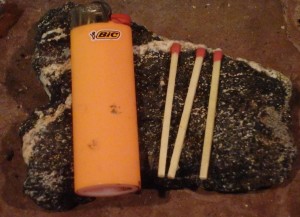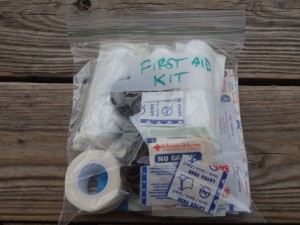Day Hiking Gear
Hiking gear can be a very sensitive topic- some hikers believe in being prepared for even the most unlikely of catastrophes, while others prefer to pack little more than a water bottle. You can load 40 pounds worth of gear in your pack, and be prepared for anything, but what’s the fun in that? Likewise, you can just take a few items in your pockets, but what happens if it rains? When you’re hiking in high elevations, you need to take extra precaution. So, here is a short list of gear that you should absolutely bring with you while hiking.
Lighter

The one on the left can light hundreds of fires. The one on the right can light three. Guess which one I take in my backpack.
There are those who prefer matches- I’m not one of them. In my opinion, nothing beats a dependable lighter. It weighs a little more than matches, yet offers hundreds of more chances to start a fire than what matches alone offer. You don’t have to worry about the lighter getting soggy (blow out any water from the spark wheel, and it will light in a few attempts), and the lighter can burn for as long as you need (useful when you’re trying to light wet tinder).
Water bottle
This goes without saying, but it’s important to bring a quality bottle with you. A Nalgene or equivalent should be used- don’t try to skate by with just a disposable bottle. You don’t want your bottle to break or leak when you are miles from your vehicle.
Lightweight and warm jacket
With the synthetic materials offered in jackets today, it’s amazing how lightweight and warm a simple rain proof hoodie can be. Just 20 years ago, we’d be carrying wool shirts in our pack. Thank goodness there are lighter alternatives today. Stuff one in your pack, and you won’t be sorry.
Extra snacks
I like to carry more than I could ever think I would need. This is especially important if you’re hiking with kids- extra snacks are a great morale boost. Kids appreciate snacks that have a little sugar in them, while adults usually go for snacks high in protein. Personally, I pack dried fruit- my kids love it, and to me it’s better than nothing.
Compass/GPS
Okay, this might be a bit of a stretch, depending on where you’re hiking. If you’re going out for a couple of miles, you can probably skip on the GPS/compass. If you’re hiking into an unfamiliar area, or an area that is hard to navigate in, then you’ll probably want to bring a GPS/compass. Unless I’m hiking in an area that I’ve been dozens of times before, I make sure to at least carry a compass with me.
Hat and sunglasses
These are two items that most people forget only once. In an alpine environment, there is no shelter from the sun. A Sunburnt retina (snow blindness) isn’t fun, and neither is the associated long term UV damage to your eyes. Some people get along fine without a hat, but for me it’s something I seldom hike without.
Ziploc bag (for trash)
Ziploc bags are great for keeping things organized in your pack, and keeping the smells associated with food down. Call me paranoid, but my snacks go in one Ziploc bag, and my wrappers/trash goes in another. This keeps my trash together (preventing any wrappers from blowing away when I open my pack), and makes my pack smell less like a granola bar. Bears have an excellent sense of smell, and the less I make my pack smell like food, the better off I’ll be.
Small First Aid Kit
I’d like to place emphasis on the word small, here. A few bandages, a couple packs of gauze, aspirin, and some tape for the gauze is all that’s required. Rather than stuff 500 of the same bandages in your kit, mix it up. Odds are you won’t need more than 3 bandages, so don’t pack more than that. Some people go all out with their first aid kits, and they weigh a pound or more. Don’t be one of those people- toss a few basic supplies into a Ziploc bag, and leave it in your day pack.
Extra Sun Screen, and Bug Spray
Pack the good stuff here, SPF 70 and 90% of higher DEET. Although both might be unpleasant to use (watch your sunglasses with the higher DEET spray, as it will damage the finish on the glasses), they’re worth their weight in gold when the sun is bearing down on you, or mosquitoes are eating you alive.
That’s it. Don’t bother bringing an extra pair of socks, an extra shirt, or anything else like that. If you’re going for a day hike, you can hike a few miles with wet feet without serious consequences. This list keeps your pack light, while still offering most of the basic supplies you will need if something unexpected happens. Let’s face it- the whole point of a day pack is to keep your pack light, so that you enjoy the hike. Leave the rest of the room in your pack for all the trout that you plan on taking back home.
